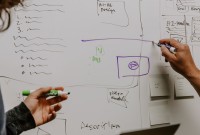- Home
- Business Processes
- Industry Knowledge
- Aerospace Industry
- Automotive Industry
- Banking Domain
- BFSI Industry
- Consumer/ FMCG Industry
- Chemicals Industry
- Engineering & Construction
- Energy Industry
- Education Domain
- Finance Domain
- Hospitality Domain
- Healthcare Industry
- Insurance Domain
- Retail Industry
- Travel and Tourism Domain
- Telecom Industry
- Leadership Skills
- eLearning
- Home
- Leadership Skills
- Leadership Theories
- Katz’s Three-Skill Approach
Katz’s Three-Skill Approach
Robert Katz identified three leadership skills called - technical skills, human skills, and conceptual skills as the basic personal skills essential for leadership. Leaders must possess these three skills that assist them in optimizing a leader's performance. Technical skills are related to the field, human skills are related to communicating with people and conceptual skills related to setting the vision.
What is Katz Three Skill Approach?
The skills theory of leadership emerged as a prominent theory in 1955 when Robert Katz published his paper "Skills of an Effective Administrator" in the "Harvard Business Review." The research was based on Katz’s own first-hand observations of executives in the workplace and on field research in administration. He suggested in the paper that effective administration or leadership depends on three basic personal skills: technical, human, and conceptual. He identified these three skill areas as the most important skills that the executives had in common and used on a regular basis.
What are the three Skill Areas?
Katz identified three skills; technical, human, and conceptual as the basic personal skills essential for leadership. Technical skills related to the field, human skills related to communicating with people, and conceptual skills related to setting the vision.
Skill 1: Technical Skills:
As defined by Katz in 1955, ‘Technical skill is knowledge about and proficiency in a specific type of work or activity. It includes competencies in a specialized area, analytical ability, and the ability to use appropriate tools and techniques’. Technical skills play an essential role in producing the actual products a company is designed to produce. Having appropriate technical skills signifies that the person is competent and knowledgeable with respect to the activities specific to an organization, the organization’s rules and standard operating procedures, and the organization’s products and services.
Examples of Technical Skills:
For a Software Company the following skills or knowledge areas can be considered as technical skills; Knowledge of Unix/Linux Operating System, Java/C++/Perl Programming Language, MySQL/Oracle Database Management, XML - Extensible Markup Language, HTML Skills, etc.
In an accounting firm, the technical skills might include an understanding of generally accepted accounting principles, accounting principles, knowledge of commercial laws, knowledge of tax laws, etc.
Attributes of Technical Skills:
- Technical Skills refer to being knowledgeable proficient in a specific type of work or activity
- It is the ability to work with things
- Technical skill is proficiency, based on specific knowledge, in a particular area of work
- Technical skills are most important at lower and middle levels of management
- Technical skills are less important at upper/senior management levels
Skill 2: Human Skills:
As technical skills relate to the ability to working with things, similarly human skills relate to the ability to work with people. Human skills are people skills that enable the leader to work effectively with subordinates, peers, and superiors. It is the leader's expertise in interacting with others in a way that will enhance the successful completion of the task at hand. Consequently, leaders with higher levels of interpersonal skills are better able to adapt their own ideas to other people’s ideas, especially when this will aid in achieving organizational goals more quickly and efficiently. These leaders are more sensitive and empathetic to what motivates others, create an atmosphere of trust for their followers, and take others’ needs and motivations into account when deciding what to do to achieve organizational goals.
- Human skills refer to the ability to work with people
- It is being aware of one's own perspective on issues as well as the openness to hear and appreciate inputs of others on their perspectives
- Leaders adapt their own ideas incorporating good themes from those of others
- Create an atmosphere of trust where employees/followers can feel comfortable and empowered to contribute their best
- Human skills are important at all the three levels of management – Lower, Middle and Senior
Examples of Human Skills:
Some human skills that are generally considered important are effective communication (both verbal and written), motivating others, and creation a positive attitude, development of cooperation and team spirit, etc.
Skill3: Conceptual Skills:
As a leader grows higher in the organizational ladder, the expectations from him are to provide strategic direction, create the vision, and motivate the folks to dedicatedly pursue the organizational goals. These are Conceptual skills that allow the leader to think through and work with ideas. Leaders with higher levels of conceptual skills are good at thinking through the ideas that form an organization and its vision for the future.
- It is the ability to work with ideas and concepts
- Creating visions, strategic plans and setting direction
- These are cognitive, business, and strategic skills
- Ability to work easily with abstractions and hypothetical situations
- As leaders climb the career ladder, higher levels of conceptual leadership skills became necessary
- This skill is most important for top managers
- This skill is comparatively less important for middle managers
- This skill is least important for supervisory managers
- Necessary skill to climb the career ladder
Examples of Conceptual Skills:
Some conceptual skills that are generally considered important are creativity, decision making, wing to wing interconnectedness, thinking as a whole, strategic thinking, problem-solving, etc.
Advantages of Skills Approach to Leadership:
One of the major benefits of a skills-based theory of leadership is that it acknowledges that anyone can become a leader. Individuals only need to find relevant resources and work hard to develop the skills of a good leader. This is encouraging for people who are interested in gaining leadership effectiveness but do not possess the traits as proposed in other trait-based leadership theories. A skills-based leadership theory also provides a competency-based toolkit to organizations to recruit, train, and grow leaders in their organization by taking inventory of each potential leader's skills in the important areas.
Limitations of Skills Approach to Leadership:
Like other leadership models, The Skills Model also has its inherent limitations because the development of many of the skills might be dependent on personal traits, and based on individual personalities it might be easier or difficult for a person to develop certain skills. This model also focuses on identifying the skills rather than clarifying why some skills influence the leadership process.
Related Links
You May Also Like
-
Life cycle theory of Leadership
Situational Leadership Theory was first introduced in 1969 as the life cycle theory of leadership. This theory suggests that type of leadership style appropriate in a given situation depends on the maturity of the follower. As per life cycle theory, leader need to match the leadership style according to the situation and leader behavior varies as the group matures.
-
The Systemic Approach to Leadership
The systemic approach to leadership looks at the organization as a whole and focuses on the understanding of the organization as a system. Moving to systems thinking demand managers to view organizations as organic systems. Leaders are also part of this complex system which is constantly undergoing change and evolving. The leaders need to manage the relations and networks within these systems by acting with systemic awareness.
-
The two-factor theory also known as Herzberg's motivation-hygiene theory and dual-factor theory. This motivator-hygiene theory states that certain factors cause job satisfaction whereas certain separate factors cause dissatisfaction in the workplace. An organization can adjust these factors to influence motivation. These factors are respectively termed as motivators and hygiene factors.
-
Authentic leadership is a new approach to leadership in which leaders are genuine, self-aware, transparent, build honest relationships, and work on an ethical foundation. Authenticity is one of the core values of leadership. Authentic leaders have truthful self-concepts and they inspire by promoting openness by acting in a real, genuine, and sincere way. Authenticity requires self-awareness and the ability to act in accordance with one's true self.
-
Contingency Theories in Action
Contingency theory suggests matching the best leader to a specific situation based on situational factors and the leadership style. The practical application of theory can be done in various ways. The workplace example is to determine the best candidate for a given set of requirements using the LPC score. Applying the model to determine a leader's ability to adapt in the scenario of a new project etc..
-
The Fiedler Model of leadership is a contingency theory and states that a leader's effectiveness is based on the situation. There is no one best style of leadership and the effectiveness of a leader in an organization depends on matching the leader to the situation. Leaders should determine the natural leadership style and assess the situation to flex the style.
-
Power is the ability to exercise influence or control over others. Leadership involves authority and it is very important for leaders to understand what type of power they're using. The 5 Types of Power in Leadership are Coercive power, expert power, legitimate power, referent power, and reward power. Authority is the right to command and extract obedience from others. It comes from the organization and it allows the leader to use power.
-
In this study of power, Raven identified five bases of power as coercive, reward, legitimate, referent, and expert. The 5 Types of Power can help you decide when it is appropriate to use a particular type of power in important situations. Leadership involves authority and it is very important for leaders to understand what type of power they're using.
-
The style approach emphasizes that one style of leadership behaviour cannot be effective in all situations. Earlier theories treated leadership exclusively as a personality trait and behavior approach has widened the scope by including the behaviors of leaders and what they do in various situations. Explore how you can benefit from the concepts to understand your own behaviors and what are some of the leadership tools based on the style approach to leadership.
-
The Psychodynamic Approach to leadership focuses on leaders building an understanding of their personality characteristics to know why they act or react in certain ways. Psychodynamics theory aims to explain the dynamics of human behavior in which lies the essence of leadership, by analyzing various motives that govern a person's behavior. This information can be used to develop leaders and followers by understanding their responses based on their personalities.
Explore Our Free Training Articles or
Sign Up to Start With Our eLearning Courses

About Us
Learning
© 2023 TechnoFunc, All Rights Reserved










